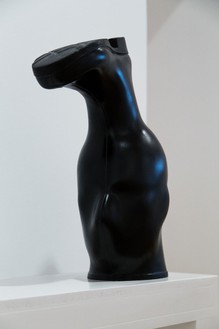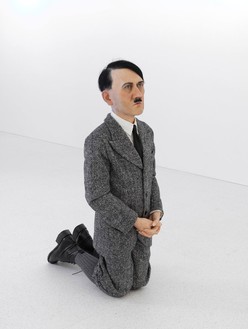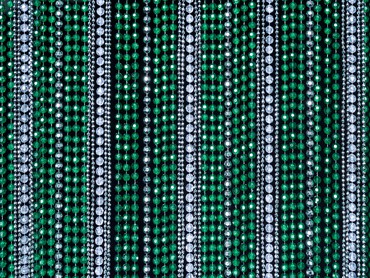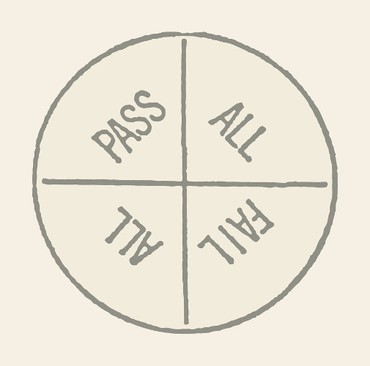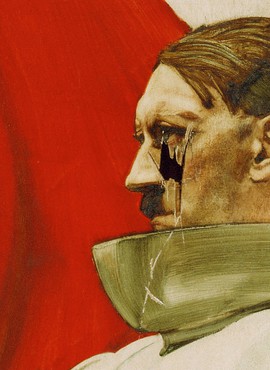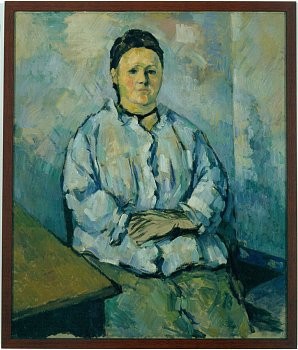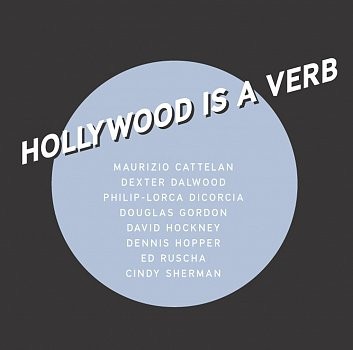About
Maurizio Cattelan’s practice is steered by an irreverent wit and a provocative drive to reexamine cultural figures and institutions, including the art world itself. Employing diverse materials, objects, and gestures in curated exhibitions and publishing projects as well as sculptures, installations, and performances, he deconstructs our ideas of context and value, revealing their often irrational roots.
Cattelan was born in Padua, Italy, in 1960, and lives and works in New York and Milan. Early on he adopted an overtly mischievous tone with works such as Errotin, le vrai Lapin (1995), for which he persuaded gallerist Emmanuel Perrotin to wear a giant phallic rabbit costume; Bidibidobidiboo (1996), an installation featuring a taxidermy post-suicide squirrel; and, in 1997 and 1998, respectively, performances in which an assistant walked around SITE Santa Fe, New Mexico, in a papier-mâché Georgia O’Keeffe costume, and through the Museum of Modern Art, New York, in a Pablo Picasso outfit with an oversize head. Cattelan’s first international appearance was at the 45th Biennale di Venezia, at which he leased his space in the exhibition Aperto ’93 to an advertising agency in the action Lavorare è un brutto mestiere (Working Is a Bad Job) (1993).
In the late 1990s, Cattelan began producing hyperrealistic figurative sculptures, making self-mocking use of his own likeness in works such as La Rivoluzione Siamo Noi (2000), in which he appears in the form of a doll clad in a Joseph Beuys–style felt suit and hanging from a coat rack. Cattelan has also courted controversy with such works as La Nona Ora (1999), a wax figure of Pope John Paul II lying under a meteorite; and Him (2001), a diminutive effigy of Adolf Hitler kneeling in prayer. In 1997, he presented two thousand stuffed pigeons at the 47th Biennale di Venezia.
Exhibitions
Museum Exhibitions

Opening this Week
Maurizio Cattelan in
With My Eyes
April 20–November 24, 2024
Casa di reclusione femminile Giudecca, Venice
www.labiennale.org
With My Eyes, the Vatican’s exhibition for the Holy See Pavilion in the 60th Biennale di Venezia, is sited within the women’s prison on the island of Giudecca and is dedicated to the theme of human rights and people living on the margins of society. The works on view incorporate the inmates’ participation in a variety of ways: some have provided photographs of themselves as children; some contribute poems for an installation; and others accompany visitors on a tour of the pavilion, alongside guards. Maurizio Cattelan’s contribution consists of a large outdoor artwork on the façade of the prison’s chapel, as well as an editorial feature, created in collaboration with the prisoners, which will be published in a special Biennale-focused issue of L’Osservatore di Strada, a monthly newspaper published by the Vatican.
Maurizio Cattelan, Mother, 1999, performance at the 48th Biennale di Venezia, 1999 © Maurizio Cattelan. Photo: Attilio Maranzano
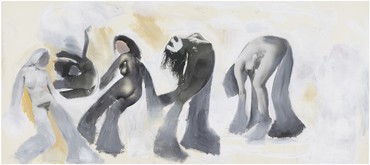
Just Opened
Effetto Notte
Nuovo Realismo Americano
Through July 14, 2024
Gallerie Nazionali di Arte Antica, Palazzo Barberini, Rome
barberinicorsini.org
This exhibition’s title was borrowed from a work by Lorna Simpson, Day for Night (2018), which translates to Effetto Notte in Italian. Curated by Massimiliano Gioni and Flaminia Gennari Santori in collaboration with the Aïshti Foundation, Beirut, the exhibition features more than 150 artworks from the collection of Tony and Elham Salamé that interrogate the meanings and functions of figuration in contemporary art and address questions around the notion of realism and the representation of truth in painting. Work by Derrick Adams, Louise Bonnet, Maurizio Cattelan, Urs Fischer, Theaster Gates, Duane Hanson, Rick Lowe, Richard Prince, Nathaniel Mary Quinn, Sterling Ruby, Anna Weyant, Stanley Whitney, and Christopher Wool is included.
Richard Prince, Untitled, 2015, Aïshti Foundation, Beirut © Richard Prince
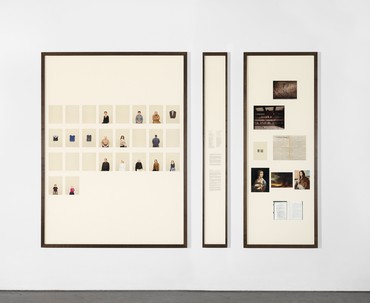
On View
Taryn Simon in
Don’t Forget to Call Your Mother
Through September 15, 2024
Metropolitan Museum of Art, New York
www.metmuseum.org
At a time when photographs are primarily shared and saved digitally, many artists are returning to the physicality of snapshots in albums or pictures in archives as sources of inspiration. Taking its title from a photograph by Maurizio Cattelan, the exhibition Don’t Forget to Call Your Mother brings together works in the collection of the Metropolitan Museum of Art, New York, from the 1970s to today. The selected works reflect upon the complicated feelings of nostalgia and sentimentality evoked by these physical artifacts, while underlining the power of the found object. Work by Taryn Simon is included.
Taryn Simon, Chapter XI, from the series A Living Man Declared Dead and Other Chapters I–XVIII, 2008–11 © Taryn Simon
